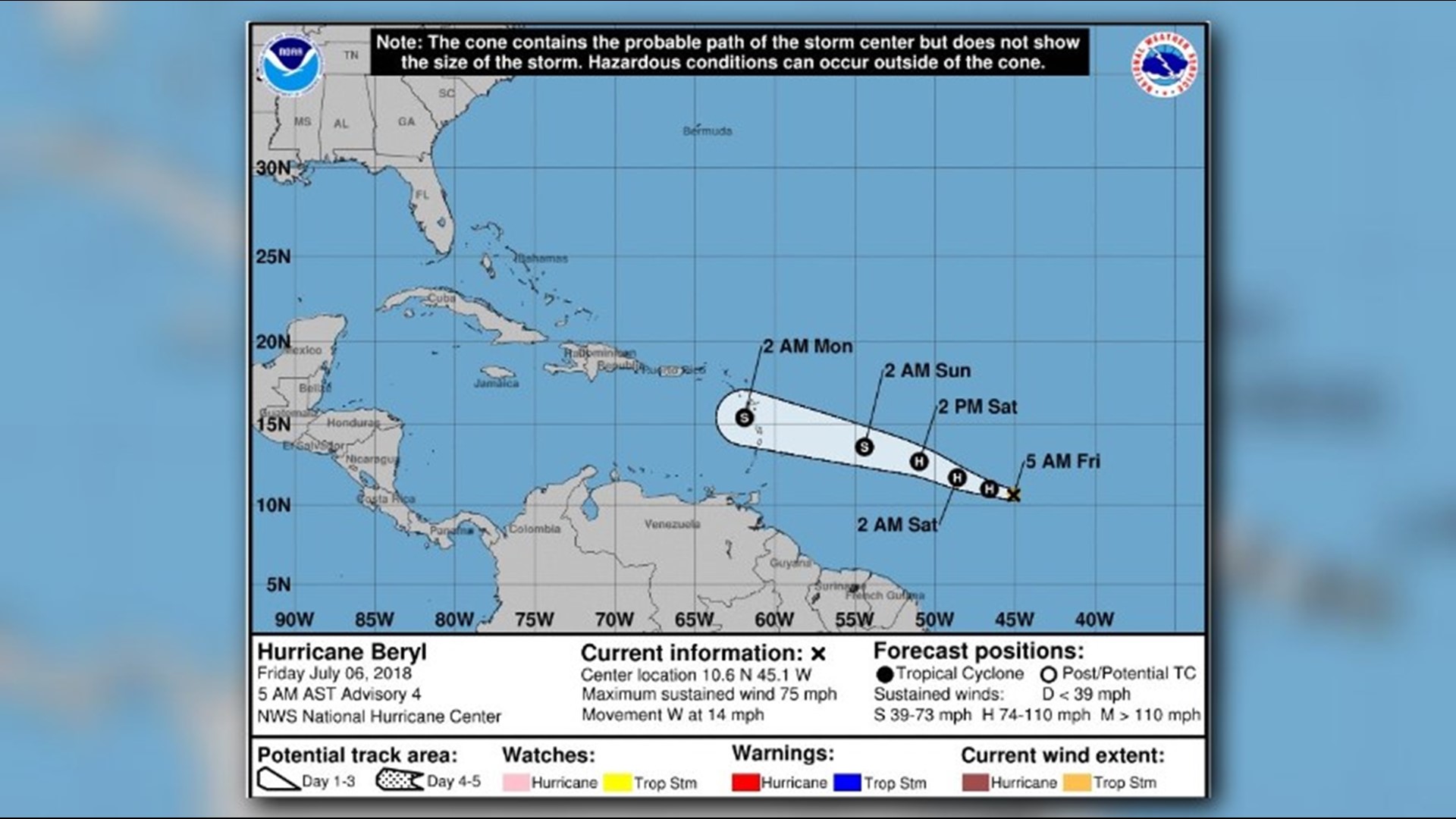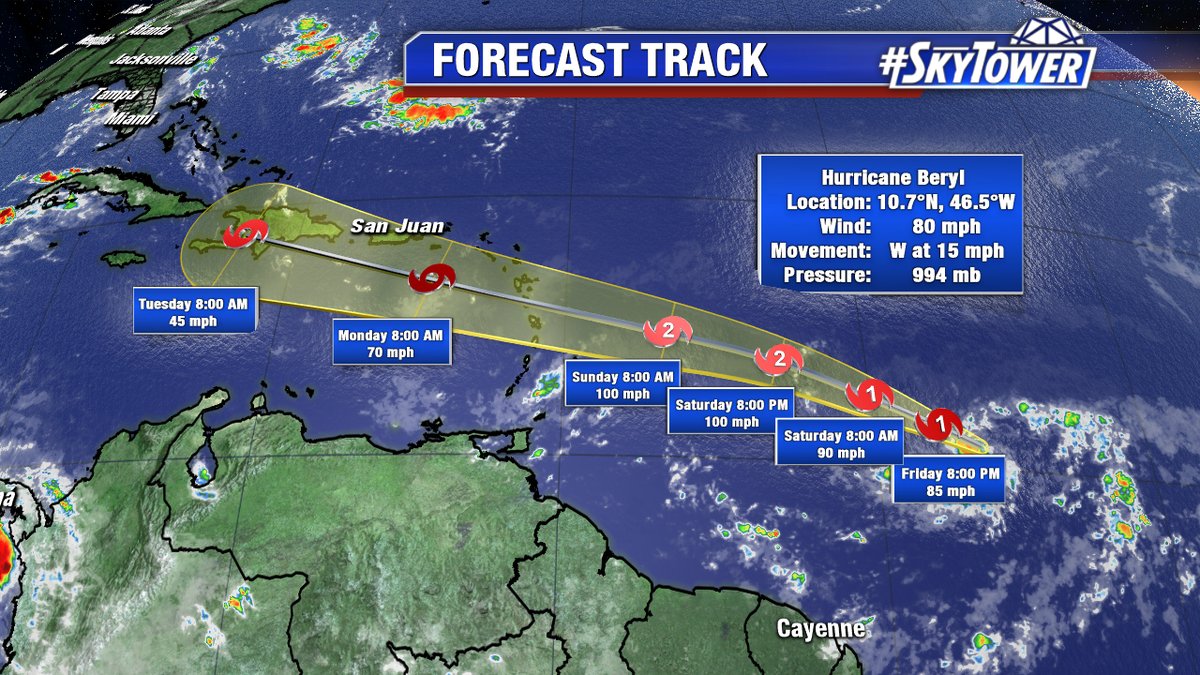Hurricane Beryl’s Path and Impact on Puerto Rico: Hurricane Beryl Puerto Rico
Hurricane beryl puerto rico – Hurricane Beryl emerged as a tropical storm on July 16, 2018, and rapidly intensified into a Category 1 hurricane by July 18. It approached Puerto Rico from the southeast, making landfall near the town of Yabucoa on July 19 at approximately 11:00 PM local time.
Upon landfall, Hurricane Beryl brought sustained winds of up to 85 miles per hour, causing widespread damage across the island. The southern and eastern regions, including Yabucoa, Humacao, and Naguabo, experienced the most severe impact. Heavy rainfall led to flash flooding and mudslides, while the strong winds downed trees and power lines, leaving many communities without electricity.
Hurricane Beryl lingered over Puerto Rico for several hours, gradually weakening as it moved westward. It exited the island on July 20, leaving behind a trail of destruction. The storm’s effects continued to be felt for days after its departure, as emergency crews worked to restore power and clear debris.
Impact on Infrastructure and Economy
Hurricane Beryl caused significant damage to Puerto Rico’s infrastructure. Roads and bridges were damaged or destroyed, making it difficult for residents to travel and access essential services. The power grid was severely impacted, with widespread outages that affected hundreds of thousands of homes and businesses.
The economic impact of Hurricane Beryl was also substantial. The storm disrupted tourism and agriculture, two key industries for Puerto Rico. Businesses were forced to close, and many workers lost income. The total cost of the damage is estimated to be in the billions of dollars.
Response and Recovery
In the aftermath of Hurricane Beryl, the government of Puerto Rico declared a state of emergency and mobilized resources to assist affected communities. Federal agencies, including FEMA, also provided support.
Emergency crews worked tirelessly to restore power, clear debris, and provide aid to those in need. Community organizations and volunteers also played a vital role in the recovery effort, distributing food, water, and other essential supplies.
The recovery from Hurricane Beryl was a long and challenging process, but the resilience of the Puerto Rican people was evident throughout. With the help of government agencies, non-profit organizations, and countless volunteers, the island gradually rebuilt and recovered.
Damage Assessment and Recovery Efforts

Hurricane Beryl left a trail of destruction in Puerto Rico, inflicting significant damage to infrastructure, homes, and businesses. The storm’s powerful winds and heavy rainfall caused widespread flooding, power outages, and structural damage.
As Hurricane Beryl relentlessly battered Puerto Rico, leaving a trail of devastation in its wake, the path of this formidable storm remained uncertain. For those seeking solace in the face of uncertainty, hurricane beryl forecast provided a beacon of hope, guiding us through the darkness with predictions and updates on the storm’s ever-changing trajectory, helping us prepare and navigate the challenges that lay ahead.
Infrastructure Damage
The hurricane’s wrath battered roads, bridges, and communication networks. Major highways were blocked by downed trees and debris, hampering transportation and emergency response efforts. Power lines were toppled, leaving thousands of residents without electricity for days.
Residential and Business Damage
Homes and businesses bore the brunt of the storm’s fury. Roofs were torn off, windows shattered, and walls collapsed. Many buildings were rendered uninhabitable, forcing residents to seek shelter in evacuation centers or with family and friends.
Response and Recovery
In the aftermath of the hurricane, local authorities, aid organizations, and the government swiftly mobilized to provide assistance. Emergency responders worked tirelessly to clear debris, restore power, and provide medical aid. Aid organizations distributed food, water, and other essential supplies to affected communities.
The recovery process is ongoing, with crews working around the clock to repair damaged infrastructure and rebuild homes and businesses. Government agencies are providing financial assistance to individuals and businesses impacted by the storm.
As the remnants of Hurricane Beryl passed over Puerto Rico, leaving a trail of destruction in its wake, the island’s resilience shone through. Like the determination of Paul George in the face of adversity, Puerto Ricans faced the storm head-on, their spirit unbroken.
As the waters receded, the community rallied together, rebuilding their homes and lives with the same unwavering resolve that had carried them through countless challenges before.
Economic Consequences of Hurricane Beryl

Hurricane Beryl’s destructive wrath left an indelible mark on Puerto Rico’s economy, disrupting industries and causing widespread financial hardship. The storm’s impact reverberated across various sectors, including tourism, agriculture, and infrastructure.
The tourism industry, a vital pillar of Puerto Rico’s economy, suffered significant setbacks. The cancellation of flights and the closure of hotels and attractions led to a sharp decline in tourist arrivals, resulting in substantial revenue losses for businesses and the government. The damage to infrastructure, such as roads and bridges, further hindered access to popular tourist destinations, exacerbating the economic impact.
Agriculture
The agricultural sector also faced severe challenges. High winds and flooding destroyed crops, decimating the production of coffee, bananas, and other staple commodities. The loss of crops not only impacted farmers’ livelihoods but also disrupted the supply chain and led to increased food prices for consumers.
Infrastructure and Recovery Efforts
The storm’s wrath extended beyond the tourism and agriculture sectors. The damage to infrastructure, including power lines, water systems, and roads, disrupted essential services and hindered economic activity. The government has implemented measures to mitigate the economic losses and support recovery efforts. These include financial assistance to businesses, infrastructure repair, and initiatives to promote tourism and agricultural production.
Social and Environmental Impacts of Hurricane Beryl
Hurricane Beryl left a devastating trail of social and environmental consequences in Puerto Rico. The storm displaced thousands of residents, caused widespread health issues, and inflicted significant damage to the island’s fragile ecosystem.
The displacement of families and individuals due to Beryl’s wrath created a significant social challenge. Many lost their homes, belongings, and livelihoods, leaving them vulnerable and in need of immediate assistance. The storm also exacerbated existing health problems and introduced new ones, such as waterborne diseases and respiratory issues.
Environmental Damage, Hurricane beryl puerto rico
The environmental impact of Hurricane Beryl was equally severe. The storm’s strong winds and torrential rains caused extensive damage to forests, coral reefs, and coastal ecosystems. The destruction of vegetation led to soil erosion and increased the risk of landslides, while the flooding contaminated water sources and disrupted wildlife habitats.
Efforts to Address Impacts
In the aftermath of Hurricane Beryl, numerous organizations and government agencies mobilized to address the social and environmental impacts. Aid organizations provided shelter, food, and medical care to displaced residents. Environmental groups worked to restore damaged ecosystems and protect endangered species.
The lessons learned from Hurricane Beryl highlight the importance of disaster preparedness and resilience. The storm exposed vulnerabilities in infrastructure, emergency response systems, and community resilience. As Puerto Rico rebuilds, it is essential to invest in measures that will mitigate the impacts of future hurricanes and ensure the well-being of its people and environment.

